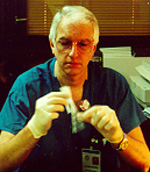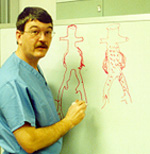Stent repair of abdominal aneurysms successful
Mounting research shows a minimally invasive treatment for deadly abdominal aortic aneurysms (AAA) is successful and results in far fewer complications than the surgical gold standard. Thirty-four research papers tracking more than 3,300 patients whose aneurysms were treated with stent-grafts are being presented today at the 26th Annual Scientific Meeting of the Society of Cardiovascular and Interventional Radiology (SCVIR). Dr.
Renan Uflacker
Dr.
Renan Uflacker
“We used to think stent-graft repair would replace the surgical alternative for about 30 percent of patients, but at some centers, it's 70 to 80 percent,” said Renan Uflacker, M.D., professor of radiology and director of interventional radiology. Uflacker presented research today from a multicenter trial that favorably compares a new custom-made stent graft to traditional surgery. “Results have been so positive that patients are considered for stent-graft repair first, even though conventional surgery is considered the standard of care.”
 Dr.
Jay Robison
Dr.
Jay Robison
Co-authors of a paper on the topic presented by Uflacker are: J. Robison, M.D., associate professor of surgery at MUSC; and J. B. Selby, M.D., professor of radiology at MUSC.
AAA (Triple A) is the nation's 13th leading cause of death and occurs in up to seven percent of people 60 and older. Every year, more than 15,000 people die of AAA, which is a ballooning in the body's main artery. It can be detected with a simple ultrasound.
In the minimally invasive therapy, a stent-graft (an expandable fabric tube) is advanced through the blood vessels and placed in the vessel at the site of the aneurysm, allowing blood to pass through without putting pressure on the aneurysm. The traditional alternative, the surgical placement of a fabric vascular graft that replaces the weakened area of the blood vessel, is a major procedure that involves a large incision in the abdomen.
AAA is a weakening in the wall of the abdominal portion of the aorta, which leads from the heart to the rest of the body. The aorta is an inch or less in diameter and typically, aneurysms that cause enlargement of the aorta smaller than 2 inches are not treated.
Aneurysms 2-1/2 inches or larger are at risk for life-threatening rupture, and usually are repaired. Patients whose aneurysms are detected at the smaller size are checked regularly by their physicians. AAA is at least four times more common in men than women. Most people with AAA have atherosclerosis, a gradual buildup of cholesterol and scar tissue that damages the walls of blood vessels. People with high blood pressure, those who smoke and those who have a family history of AAA also are at risk.
Two stent-grafts, also known as endografts, are FDA approved for AAA, with several others undergoing clinical trials, including the Talent stent-graft reported on by Uflacker in the Phase II 17-center trial. The Talent stent-graft treats a wider range of patients because it can be used for people with larger aortas. Unlike the approved stent-grafts, the Talent stent-graft is custom-made for each patient, at about the same cost.
In the Talent trial, 123 patients had traditional surgery and 246 patients received the new stent-graft, 173 of whom were analyzed in this study. In the stent-graft group, treatment was successful in 133 of the 173 patients (77 percent). Immediately after treatment, 39 patients (23 percent) experienced leakage into the aneurysm sac. Many needed no treatment. Others had one of several treatments, including embolization, an interventional radiology technique that cuts off blood flow to the problem area to prevent further leakage. After 12 months, 5 of 45 patients (12 percent) continued to have leakage, but none required treatment. Within 30 days after treatment, 2 stent-graft patients (less than 1 percent) died due to procedural complications; no surgical patients died.
After 30 days, 5 (4 percent) surgical patients had died vs. 13 (5 percent) stent-graft patients. None of the post-30 day patient deaths were attributable to the procedure. Most died of cancer, heart disease or pulmonary disease.
Complications were far more likely after surgery than after stent-graft repair. All 246 stent-graft patients were analyzed for complications. Stroke and other neurological complications occurred in 23 patients (19 percent) for surgery vs. 15 (6 percent) for stent-graft repair. Other complications included: bleeding 73 (59 percent) vs. 71 (29 percent); cardiac complications such as arrhythmia in 39 (32 percent) vs. 32 (13 percent); and pulmonary edema and breathing difficulties in 33 (27 percent) vs. 10 (4 percent).
The interventional radiology AAA technique involves making an incision in the groin and, under X-ray guidance, inserting a catheter into a blood vessel that leads to the aorta. A collapsed stent-graft is inserted through the catheter and moved to the site of the aneurysm, where it is deployed, reinforcing the aorta and creating a stronger pathway for the blood. Blood flowing through the stent-graft no longer puts pressure on the ballooning walls of the aneurysm, which are outside of the graft. Typically the patient is lightly sedated and has been given epidural anesthesia. The hospital stay is usually four days or less and recovery takes an average of 11 days.
The traditional alternative, conventional surgical replacement of the damaged portion of the aorta, is performed under general anesthesia. An incision is made in the abdomen to enable the surgeon to reach the site. The aorta is clamped off, the aneurysm is cut out and the artificial artery—a fabric graft—is sewn into place.
The average hospital stay is 8 to 10 days and the average recovery time
is 47 days.